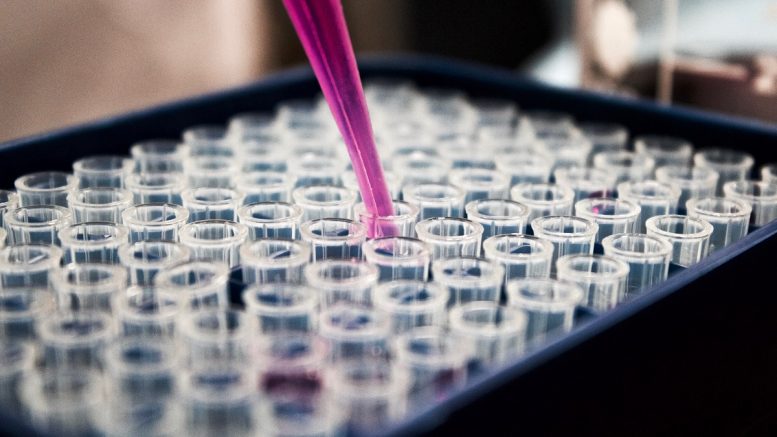Liquid biopsies — blood tests that provide an alternative to traditional surgical biopsies — are making it easier to detect, monitor, and treat cancer. In fact, liquid biopsies can even improve the survival rate for people with lung cancer, a recent study published by researchers at Memorial Sloan Kettering Cancer Center (MSK) reveals. As they’re able to detect molecular changes in the tumor, liquid biopsies can highlight the drugs most likely to be successful for any given cancer patient. Although liquid biopsies are not yet available for use for most types of cancer as they’re still a fairly new technology, they’re now increasingly being used for patients with non-small cell lung cancer.
Liquid biopsies: a proven and “significant lifesaving benefit”
“Our study showed there’s a real, significant lifesaving benefit from liquid biopsy,” says the study’s senior author and thoracic oncologist, Bob Li, MD, PhD, MPH. “When we were able to match patients with targeted therapies, they survived much longer.” In the study, 1,127 patients currently being treated for non-small cell lung cancer were given liquid biopsies. Tumor DNA was consequently identified in the blood of 723 patients, while 255 patients were found to have “genomic alterations” in their blood that corresponded with targeted therapies. And, another 163 patients were also paired up with drugs according to the results of their tissue analysis. Ultimately, the patients who received targeted therapies enjoyed a longer lifespan — a 37% decrease in mortality — than the patients who couldn’t be matched with targeted drugs. “The magnitude of benefit that patients get from targeted therapy is really huge,” says study author and MSK medical oncology fellow Justin Jee, MD, PhD. “In the past, having high levels of tumor DNA in the blood was a sign of a worse prognosis, but now we can turn that around and use it to offer more effective treatments.”
The science behind liquid biopsies
As cancer spreads throughout the body, cells typically start to break off and circulate the blood stream. Liquid biopsies can identify these cells via a simple blood draw. Specifically, liquid biopsies are used to detect either circulating tumor cells (CTCs) — which are tumor cells circulating the blood — or circulating tumor DNA (ctDNA) — which is single- or double-stranded DNA that’s shed from the tumor and now circulating the blood. In addition to detecting cancer, liquid biopsies can also be used to verify an existing cancer diagnosis made via a traditional biopsy, such as a fine needle aspiration biopsy or core needle biopsy (these are the most common methods used to diagnose and treat most forms of cancer).
Simplifying the health screening process
Aside from identifying the right drug to treat a patient’s cancer, liquid biopsies offer numerous other benefits to patients. Specifically, the process of obtaining the sample is made simpler and safer for the patient. “It transforms the experience for the patient. A liquid biopsy means that essentially, you go to your GP and the sample travels, not you,” explains Dr. John Lock, a cancer researcher at UNSW Medicine & Health and the Ingham Institute for Applied Medical Research. They’re also less invasive than traditional biopsies, requiring just a few vials of blood. With traditional biopsies, on the other hand, the patient must visit the operating room for the procedure. Cancer screening can be a stressful and uncertain experience for patients, so simplifying this process can do a lot to lessen the emotional burden and improve quality of life. Similarly, financial aid is another crucial tool that can aid peace of mind as much as possible during this uncertain time. Disability benefits like Medicaid and Medicare, in particular, typically cover medically-necessary biopsies used to detect cancer, as well as other diseases. Medicaid provides healthcare coverage to people on low-income and with disabilities, while Medicare is aimed at those over 65, as well as younger people with disabilities.
A multi-pronged tool
Moreover, liquid biopsies can also be used to achieve a variety of goals. For instance, they’re increasingly playing a key role in the early screening process to detect cancers. And, since results can usually be generated quickly — and much faster than with regular biopsies — patients can therefore begin new treatments sooner. Various multi-cancer screening blood tests are also currently being developed. Liquid biopsies can also be performed frequently to monitor the development of a patient’s cancer over time; this can show whether or not the tumor is changing in response to treatment, and whether or not a different approach is needed. “In fact, liquid biopsies are just as important as scans for detecting when a patient’s disease has started to come back or spread”, says Dr. Jee.
Liquid biopsies are transforming cancer detection, monitoring, and treatment. Already proven to decrease mortality for lung cancer patients, liquid biopsies show groundbreaking promise for improving outcomes in all cancer patients.
By Briana Hilton





